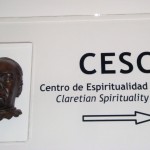En este espacio se almacenan las noticias relacionadas con el CESC.

Presentation of volume XXXVIII of Studia Claretiana

Indeed, in the “Studies” section, there are six contributions. In the first, our frequent collaborator, the Claretian Severiano Blanco, offers a historical synthesis of how Claret was developing, after several attempts, the idea of founding a group of missionaries that would dedicate themselves to popular preaching, in a historical period of its absence and even prohibition by the government of the nation. In 1849, Claret definitively founded the first community in Vic, which was later followed by others. (more…)
The apostolic prayer
This is a prayer widely used by Saint Anthony Mary Claret and that he himself includes in his Autobiography. With some slight variations from the original, it sounds like this:
“My Lord and Father,
may I know you and make you known
may I love you and make you loved
may I serve you and make you served
may I praise you and make you praised
by all creatures. Amen”.
Claret adds more elements, but the essence is reduced to the set of the four verbs applied to God: know, love, serve and praise. With the initials of each of them, in Spanish, the word “casa” (house) is formed (conocer, amar, servir y alabar) It is a simple way to remember that Claret – like Jesus – dreamed of being in the Father’s house to devout himself to His affairs and not to his own interests or tastes. (more…)
2nd Meeting of archivists

The meeting began at 10 in the morning at the CESC premises in Vic. And we went through the agenda set in advance. After the greetings and introduction of the attendees, especially the new archivists; we went on to presentation of recent and important works by the respective Archives. A good amount of time was spent providing detailed information about the work and the peculiar characteristics of the CESC in its three dimensions of research, animation and dissemination of the personality, works and writings of Saint Anthony Mary Claret and the Claretian Family. We stopped in particular to show the website of the Centre. (more…)
Furniture used by Father Claret in the Canary Islands

It was here in Agüimes, where the people called him S. Antonio María Claret for the first time, and where he celebrated the only festivity of Corpus Christi, during his stay in the Canary Islands. His time in the Canary Islands was so important that our compatriot Mr. Joaquín Artiles divided the history of the Canary Islands into two stages: before Father Claret’s time and after his stay among us.
The apostolic missionary D. Antonio Claret, shortly after his departure to the peninsula, founded the congregation of the Immaculate Heart of Mary. A few months later he was appointed archbishop of Santiago de Cuba, where he suffered an attack when he came down from the pulpit. Queen Elizabeth II appointed him as her confessor; He attended the First Vatican Council and, upon being exiled, accompanied her into exile. He died in Fontfroide (France), on October 15, 1870, days before the death of the former parish priest of Agüimes, during the mission, D. Juan Pedro Saavedra. His body lies incorrupt in the temple of his name, in the city of Vich (Gerona). He was beatified by Pope Pius XI on February 25, 1934 and canonized by Pius on April 13, 1951.
Banished, but not lonely


